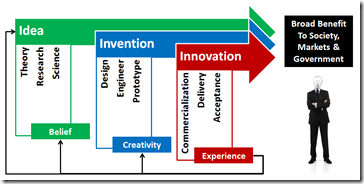 With the advent of the “Social Era”, invention is just invention. Patent the intellectual property (IP) to heart’s content, but invention is still just not innovation.
With the advent of the “Social Era”, invention is just invention. Patent the intellectual property (IP) to heart’s content, but invention is still just not innovation.
I recently re-read a good blog post from October 2012 on the Harvard Business Review Blog site recently, by Rita McGrath titled “A Brief History of Inventing Innovation.” The article and comments reminded me that, it’s time for yet another reality check.
I wrote a blog post differentiating these terms a year ago in “Innovation Continuum – Clarity Around a Powerful Valuable, but Overused Word.” There is a clear difference between an idea, an invention, and an innovation.
Industrial Era: Innovation Field of Dreams
 Historically (in the Industrial era of the last century) invention and innovation were terms all too often used interchangeably. The guys in white coats in corporate and academic research and development (R&D) labs didn’t see the need to differentiate between the terms. There was no one keeping them honest.
Historically (in the Industrial era of the last century) invention and innovation were terms all too often used interchangeably. The guys in white coats in corporate and academic research and development (R&D) labs didn’t see the need to differentiate between the terms. There was no one keeping them honest.
If they built it, and customers didn’t come (now known here as The Field of Dreams Strategy), it was everyone else’s fault. Rarely was the connection made that invention was not commercially viable innovation without marketing (the kind that drives the connection between product, place, promotion and price – yes, those pesky 4Ps).
Innovation initiatives should show a little more confidence than Kevin Costner’s face conveys as he cuts down profit-producing crops to build a baseball field motivated by voices in his head!
Industrial Era: Statistical Crap Shoot
In the Industrial Era, it was more probably a statistical crap shoot. That is for the R&D lab to work under the premise: “If we invent enough unique things, then statistically, one will stick.” 3M’s Post-it note came out of this industrial era approach. Glue that failed (invented by Spencer Silver), was re-purposed (by another inventor/chemist, Art Fry).
In the crap shoot model, the “inventor” would then take profound all-encompassing credit for that single invention. And many in the lab’s mutual admiration community would even brand him an “innovator.” More subliminally the hope was that the wasted effort, time and money on other dead-end invention would then fade from everyone’s memory.
For the record before I go further (or the Post-it note police come after me), know that I do like 3M, the Post-it note, and respect how we got via the industrial era.
Social Era: Better Statistical Probability
I’m not suggesting that the 3M example is any less significant. Clearly, failure is critical to innovation, and something that we should value in our processes.
I am pointing out that in the Social Era; we need more differentiation and rigor around guiding our effort, and differentiating between invention and innovation. Specifically, successful startups and large corporations alike must focus on stimulating well-founded invention R&D / engineering effort that has higher probability to become innovation.
Most of the time, one doesn’t have the backing of a company, or the time, to “figure it out” like 3M gave its inventors. For those inventions, they just fade away from memory, only to be found in the archives of the patent office as quackery, if they were filed at all.
Social Era: Transparency and the Customer
Of course now, we know that this old way of confusing invention with innovation is fundamentally because the idea was not evaluated with customers, before the cost was incurred (again, marketing).
Can anyone name the marketers that branded the Post-it note? Can they name the marketing innovator that built the channel (back before big-box office-supply stores existed!), and ensured its success in the market? Do they have a page on Wikipedia documenting their contribution to turning a cost-incurring invention into a commercially viable innovation that created untold profit for 3M? I didn’t think so.
Snake Oil and Innovation Leaders
Many “innovation” experts today fail to make a commercial viability and profitability distinction between invention and innovation. Propagating the industrial era’s undifferentiated notion that invention is still innovation is like selling snake oil. It makes the audience feel that they must spend on innovation blindly, when they could have much better probability for success just by understanding the difference.
For me, when I meet with a client, just getting these two terms differentiated in the minds of leaders is a huge win. Even if I don’t earn the consulting business, I feel they now stand a much better chance to grow profitably through innovation, if only because they can recognize it.
Pivot: Startup or Big Company
You hear about “pivot” strategies lately. And, also we know incredible innovation is happening at startups and small and medium (and large) companies. Startups pound the proverbial head against the wall trying to do start-up pivot after pivot, again and again, until someone finds enough value to buy it. It’s almost kismet after duping (I mean convincing) Angels or VCs to invest.
A few simple questions from a well-educated marketing professional can make all the difference. Who is the customer? Why will they buy (pay money to have it – that’s commercial viability)? How does the business model work and scale over the long-term? And, other differentiating questions that increase the probability of innovation.
Ponder: Differentiate Invention from Innovaiton in the Social Era
In reality, one has to separate in their mind, that “invention” is just invention. The creation of technology or service products, without CMO level insight is a repeat of the Field of Dreams strategy (if we build it, they will come, or else it was not enough marketing and sales effort). This almost never works. And, when it does, a CFO should be screaming somewhere asking “why didn’t Marketing, Sales and R&D work together to manage costs better through collaborative processes?
Remember: All good ideas that become inventions and even ones that earn a patent are not innovation. Invention transitions to innovation when the connection between IP and customers interest to buy is made. Then business and commercial viability (measured in profit), is proven. Yes, statistics and data are valuable here.
The Social Era makes this differentiation profoundly obvious. The 9 out of 10 startups that fail, and many of the established businesses that are failing, have likely not made this distinction in one way or another. Consumers are no longer duped by big corporate ad campaigns. And, they are vocal (the social media voice can be deafening) when what is called “innovation” is really just a flop.
Please leave a comment, share with others your thoughts.
And, please share this post via Google+, LinkedIn and Twitter for your colleagues. I am grateful if it is valuable to you and them.
Image Credit, Innovation Continuum, Andrew Stein. Field of Dreams: Universal Studios Home Video. Post-it Note, 3M.










[…] With the advent of the "Social Era", comes innovation Field of Dreams. […]
Great post. Rather than shorter.. what about using this as a framework to dive into each in greater detail with more examples (both good and bad)?
Thank you James. This is great advice. Certainly some of these main points deserve their own visibility and exposition in a separate blog post. I’ll have to work on that more, and balance that with the time available over sparking thinking and discussion.
Andrew,
You make a lot of powerful points here, many could stand alone as separate posts.
Often I find that small & mid sized companies feel that they need a R&D department to give themselves either credibility or an additional selling point. As there is rarely strategic direction for R&D, most departments spend time and resources recreating competitor products with the goal of shaving off a few cents in material costs so that marketing and sales can compete on the basis of price. An approach that dooms a company to failure.
Secondly, few companies ever ask customers if they need or want new products. There seems to be a mindset that as there is a relatively nominal cost to adding new feature to an existing platform that it should be done. To leave something out that a customer “may” deem critical would shrink the potential market. The problem than becomes that products and services become so cluttered with features that customer don’t use, that discovering the features customers would find valuable becomes an exercise in futility.
I think your point that a few simple questions can make all the difference to a company’s ability to survive or fail is right on and recall the invention of New Coke as a classic example of the Field of Dreams strategy in action. Gotta wonder where the CMO level insight was on that decision.
Thank you Kell. Coke has a lot of good case studies, this being one of them. I have to work on shorter posts – it is my goal, and constant challenge.